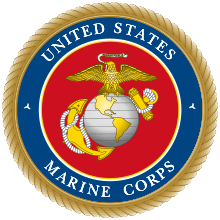Naval Mobile Construction Battalion 133
Naval Mobile Construction Battalion 133 (NMCB 133) is a United States Navy Construction Battalion, otherwise known as a Seabee Battalion, homeported at the Naval Construction Battalion Center (Gulfport, Mississippi) (aka: Naval Mobile Construction Battalion One Three Three – or – One Thirty Three). The unit was formed during World War II as the 133rd Naval Construction Battalion. It saw action and was decommissioned shortly after the war ended. The unit was reactivated as Mobile Construction Battalion 133 for the Vietnam War and remains an active unit today.
| Naval Mobile Construction Battalion 133 NMCB 133 | |
|---|---|
 NMCB 133 insignia | |
| Active | 17 September 1943 – 1946 12 August 1966 – present |
| Country | United States |
| Branch | USN |
| Homeport | Construction Battalion Center Gulfport |
| Nickname(s) | "Runnin' Roos" |
| Motto(s) | "Kangroo Can Do" |
| Engagements | Iwo Jima Vietnam War Operation Provide Comfort Gulf War Operation Joint Endeavor Operation Enduring Freedom Operation Iraqi Freedom |
| Commanders | |
| Current commander | CDR Frank W Carroll |
History
WWII – Iwo Jima: 133 Naval Construction Battalion
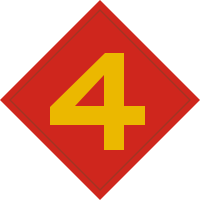
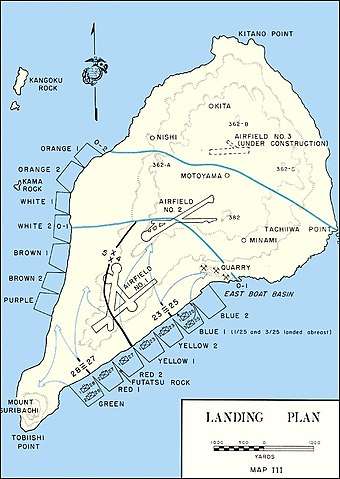

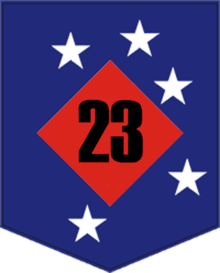
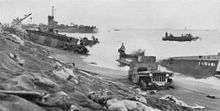
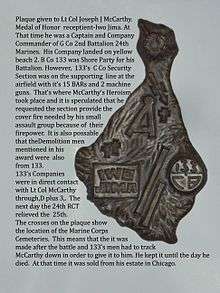
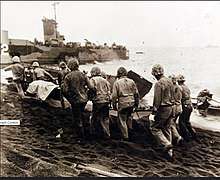
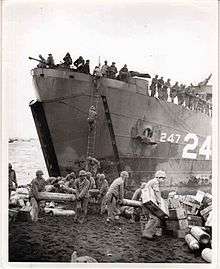

The unit's history began on 17 September 1943 at Camp Peary, Virginia, where it was commissioned as the 133rd Naval Construction Battalion (NCB). After 7 months of training at Davisville, Gulfport and Port Hueneme the battalion's first overseas assignment was NAS Honolulu, Territory of Hawaii (May–October 1944). On 15 October 1944 word was received that the battalion was going to be attached to the 4th Marine Division.[1] On 30 October the assignment came for Operation Detachment at Iwo Jima. D-day was planned for 19 February 1945. When 133 was attached to the 4th it was filling a billet that had been vacated when the 121st CB was released by the Marine Corps. The 121st CB had been transferred to the Marine Corps and re-designated as the 3rd Battalion of the 20th Marine Regiment. After the assault of Tinian the 20th Marines were inactivated. Then both the 1st battalion (4th Engineers) and 2nd battalion (4th Pioneers) were placed under Divisional control. Third battalion 3/20 or the 121st, was returned to the Navy creating the vacancy 133 was posted to. Before joining the 4th at Camp Maui, the 133rd was put through the Army's Pacific Jungle Combat Training Center (CTC) at Schofield Barracks on Oahu, TH.[2] Camp Maui was located along the North shore at Haiku-Pauwela.
Once assigned to the division the battalion had each company detached and "tasked" to a different element of the 23rd Marines for shore party training. The battalion's shore party assignment was to provide the beach support required by the forward lines of the 23rd, 24th, and 25th Marines . The division shipped out for Island "X" on 31 December with V Amphibious Corps (VAC) as T.U. 56.2.2 of Baker Landing Group. Baker group was commanded by Major General C.B Cates USMC of the 4th Marine Division.[3] When they were a few days out the men learned they were heading to a place they had never heard of called Iwo Jima. The assault for Iwo was based upon Tinian where the 2nd and 4th Marine Divisions assault had been "reinforced" by Marine Engineering Regiments with the 18th and 121st CBs as 3rd battalions respectively. On D+3 the Jap airfield was secured and the Seabees had it operational in a few hours.(the Iwo Jima landing map is notated that the Marine Corps planned to have control of Iwo Jima in 3 days also) For Iwo the 4th and 5th Marine Divisions were "reinforced" by the 133rd and 31st NCBs. Marine Corps landing maps indicate that for O-1 (objective Day 1) Motoyama Airfield No. 1 would be secured and 133 was tasked to get it operational.[4] However, D+5 the assignment was given to the 31st CB due to the losses 133 had suffered. The next day 62 CB landed with the 3rd Marine Division and was designated the lead Battalion for Airfield No. 1. The 31st was assigned Airfield No. 2 and the 133rd was given Airfield No. 3. In just seven days the heavy equipment of the 3 combined battalions had Airfield No. 1 operational.
The 133rd CB and the 4th Marine Pioneer Battalion were the primary units of the "Assault" shore parties for the 23rd and 25th Regimental Combat Teams (RCT) on the 4th Marine Division's yellow and blue beaches.[5] The 4th Marine Division's single Pioneer Battalion was assigned to the 25th RCT. USMC tactical operations required another Pioneer battalion for the 23rd RCT's Assault. The 121st CB had been tasked as such at Roi-Namur, Siapan, and Tinian so giving that task to the 133rd was simply standard 4th Marine Division operations.[6][7] Tasking Seabees for USMC shore party at Iwo was a fortuitous decision for the Corps. The CBs brought organic elements the Marines did not have, specifically, bulldozers with winches and D8s 132–148 Hp compared to the Marine Corp's TD 18s 72–80 Hp. Afterwards, the after action reports recommended all USMC bulldozers be equipped with winches as they had none. The history is, that "on the beach at Iwo, bulldozers proved to be worth their weights in Gold"[8] and the CBs had the biggest and the best the Navy could provide.[9]
The Landing Force Shore Party Commander was OIC of the 8th Marine Field Depot.[10]
Hq Co was posted to the 23rd Marines support group and was the Hq for yellow beaches 1 and 2.[11] They came ashore at 1445 from the APA 196 – USS Logan. The Company had two 30 man infantry security sections plus two 30 cal. machine guns on the beach defense line until their ratings were needed. The medics had one Dr. MIA another Dr. and Dentist wounded while many of their corpsmen were casualties. Even so, 133's corpsman established a Medevac station on blue 1. Also with Hq Co was a 32-man depot team from the 8th Marine Depot Company to manage the depots on yellow beaches.
- On D+2 yellow beach was closed to landing craft due to all the destroyed or inoperable equipment along the water's edge. UDT 14 was assigned to beaches yellow 1 and 2[12] and was ordered back ashore to help 133 get the waters edge clear for landing craft to continue the assault.[13]
A Co was the major component of the shore party posted to 1st Battalion 23rd Marines or 1/23 which was the left "Assault" battalion for yellow beach. D-day they landed a 0935 on yellow beach 1 from APA 158 – USS Newberry[14][15][16] and LSM 206. A Co 4th Pioneers was split in two to share their combat experience/knowledge and was attached to A Co 133.[17] One of A Co's security sections (30 men) landed in 4 LCVPs with one 7-man gun crew and 37mm Gun M3 in each craft.[18] One LCVP took a direct hit killing the entire gun crew. 133's gun crews were immediately tasked with supporting the assault. A Co's other security section landed on the heels of the first wave. The USN beach party from the USS Newberry was attached to A Co.[19] Also with A Co was a 32-man beach team from the 8th Marine Depot Company.
- 1/23 was so decimated that 3/23 relieved them from the line by evening of D-day. D+3 the entire 23rd was in such a bad way that it was placed in Corps Reserve, replaced by the 21st RCT from the 3rd Marines. At that time 133's Shore Parties were consolidated on yellow 1 while the 3rd Pioneers landed on yellow 2 for the 21st until D+6.
B Co was the major component of the shore party posted to 2nd Battalion 23rd Marines or 2/23 which was the right "Assault" battalion for yellow beach. They also landed at 0935 but on yellow 2 from the APA 207 – USS Mifflin[19][16] and LSM 202. A Co 4th Pioneers was split in two to share their combat experience/knowledge and was attached to B Co 133.[17] B Co's security sections landed the same as A Co. The USN beach party from the USS Mifflin was assigned to serve with B Co.[20] Also with B Co was a 32-man beach team from the 8th Marine Depot Company. 2nd Battalion 23rd Marines had three LSTs numbers: 587, 761, and 812.[16]
C Co was posted to the 3rd Battalion 23rd Marines or 3/23 which was the reserve "Assault" battalion for yellow beach. They landed D-day at 1220 from the APA 154 – USS Lowndes[19][21][16] and LSM 145. Their security section advanced to the edge of the airfield. (see: Joseph J. McCarthy) The beach-master made C Co Commander the Commander of yellow beach 2 on D+6 when the 21st's Shore Parties moved to black beach (which was created from the right half of beach red 2 and the left half of yellow 1). A 43 man beach party from the USS Lowndes served with C Co.[19][22]
note: WWII CB security sections were the equivalent of a heavy weapons platoon today.
- See the "External links" section for: Col. Shelton Scales comments on C Co. 133 a and the shore party Log for yellow and blue beach's D-day through D+18.
D Co was posted to the 4th Pioneer Battalion's reserve. The 25th Marines lists them in their "support group".[23] However, the 4th Marine Div. Operations Report of April 1945 places them in the 25th's "Assault reserve" with 2/25 on APA 190 the USS Pickens. The 25th had just 2 LSMs assigned to the Shore Party so D Co's equipment would have been on LSTs. They landed at 1600 on blue 2. They were "tactically disposed" and told to dig in.[24]
USN WWII phonetic alphabet used to identify individual Companies: A = Able, B = Baker, C = Charlie, D = Dog [25]
- Annex Fox to the 4th Marine Division's Operations Report of the 23rd RCT states that the Navy did not relinquish operational control of the USN beach parties to the USMC shore parties.
The Unit Histories of both the 4th and 5th Marine Divisions state that the conditions on the beach for the (Red Patch) Shore Parties and the (yellow patch) USN Beach Parties were worse than the front lines. D-day all personnel were initially employed to aid the evacuation of casualties. From D-day until D+5 the men were on duty 24 hrs a day. To get sleep men would go up to the front lines where it was safer. D+5 to D+8 work was 4 hrs on 4 hrs off. From D+8 to D+14 work was 4 hrs on 8 hrs off. On D+14 it changed to straight 8 hr shifts. The corpsman, security sections, equipment operators and truck drivers were on call at all times, from the beginning to the end of the assault.[26] On D+18 (9 March) 133's Companies were relieved by the Army Garrison Shore Party. The battalion reorganized and returned to the Navy.
The battle for Iwo Jima took 26 days. In that time 133 suffered 328 casualties, with 3 officers and 39 enlisted KIA and 2 MIA.[27] It was the price paid for being ordered into USMC fatigues and landing battalion strength in an assault tasked as a USMC Pioneer Battalion.[28] Their losses were the highest ever for a Seabee unit. The battalion was awarded the Navy Unit Commendation the same as the other 3 shore party battalions: 4th Marine Pioneer, 5th Marine Pioneer and 31st CB. However, the unit is incorrectly listed in the NUC Section of the Iwo Jima awards.[29] It should read "133rd NCB (less Companies A, B, C,and D)". This is how the 4th and 5th Pioneer Battalions were listed. Had this been done then A, B, C and D Companies would have been listed in the PUC section for being assigned to their respective Assault Battalions 1/23, 2/23, 3/23 and 2/25[30] exactly the way the Pioneer Companies were for their PUC's. The 4th did not follow protocol and put the entire Battalion up for the PUC like it had done with the 121st on Saipan. All of the shore party battalions were designated "Support" so it was automatically rejected. It was the individual companies that were posted as "Assault". Marine Commandant Gen. Vandergrift recommended that the PUC be given to all the "Assault" units and the NUC to those designated "Support". Fox Annex to the 4th Marine Division's Operations Reports, dated April 1945, show 133's Companies individually as "Assault" components. A footnote to the awards is that in addition to all the Purple Hearts 133's men received 10 Bronze Stars and 29 Marine Commendations.[31] Before that happened the battalion would crush over 100,000 tons of rock, move over 1 million cubic yards of earth, lay 5,800 feet of drainpipe, install 4,000 feet of conduit and pour 725 yards of concrete.[32] 133 graded the site and built the entrances for both the 3rd Marine Division and the 4th Marine Division at the cemetery on Iwo. After the three airfields had been completed Admiral Bull Halsey stated "that if needed, the Seabees could make (another) island and put ... five airfields on it".[33]
USMC commendatory Iwo Jima observations
- Capt. Jesse L. Massey, Quartermaster 8th Marine field depot. "No words of tribute can express what those boys did. Nothing I could say would be adequate. They were brave resourceful enough to carry out a difficult assignment under the most hazardous conditions."[34]
- Warrant Gunner Carl H. Gerlach Ord. Company 4th Marine Div. "I saw Seabees of the 133rd carry ammo to marines on the front lines until we could set up a dump behind the lines. I understand they were under fire for the first time. The work I saw done by members of the battalion was as fine an example of Seabee "Can Do" as will ever be turned in by any outfit."[34]
- Col. Shelton Scales Commander 3rd Bn 23rd Marines recommended 133 for the PUC. His statements were documented in an interview with LtCol. Oliver North for War Stories. [35][36]
- Lt. General Snowden USMC (commanded Company I, 3rd Battalion, 23rd Marines) recommended 133 for the PUC to the Board for Correction of the Naval Record.[37]
On 28 September 1945 the 9th Construction Brigade informed 8, 31, and 133 NCBs that they were detached from the 41st Construction Regiment on Iwo Jima and would act independently until reassigned.[38] In October some of 133's men went with the 31st NCB to Sasebo, Japan for the occupation reconstruction (and were discharged at Bremerton, WA in January 1946). In late November 1945 the 133rd was moved to Guam. On 1 December, it took over the work orders of the decommissioned 25th NCB. The same fate awaited the 133rd later that month on the 27th[39] due to the reduced need for the existing Naval Construction force.
- NAS Honolulu, 133's first deployment site, is today the location of Honolulu International.
The 133rd that landed on Iwo Jima had an insignia drawn by Hank Porter at the Walt Disney Studios Insignia Department. A second class Jack E. Dorn – 3rd platoon D Co.[2] sent a request to the Disney Studios on 9 December 1944 from Camp Maui, TH. The Studios received it on 26 December and sent the completed design in June 1945. The battalion received Disney's drawing on Iwo Jima. That insignia was of a Seabee walking, carrying a hammer and monkey wrench while chewing his oats.[40] "RAIN-MAKERS" was the moniker those men used as they felt it rained everywhere they went (the Fightingfourth website states it "Rained-how it Rained" at Camp Maui and on Iwo it poured on D+3). It also was the name they used on the Unit History published in 1946.[41]
Vietnam, MCB 133

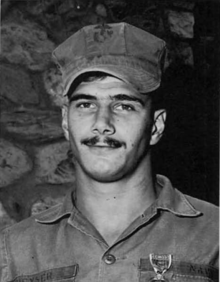
The battalion was reactivated 12 August 1966 in Gulfport, Mississippi, as a Mobile Construction Battalion.[42] It seems the battalion did not have a copy of the unit History from WWII with the Disney insignia and there was a belief that the battalion's first deployment was supposed to have been Australia. This belief produced the Kangaroo insignia and the slogan "Kangaroo Can Do".(actually, most CBs have created a new insignia when they were recommissioned) After completion of training in Gulfport and Camp Lejeune they deployed to Đà Nẵng East, Vietnam. The battalion was awarded its second Navy Unit Commendation for this tour. The second deployment to Nam took them to Phu Bai Combat Base. This time they had a huge project laying 10,000 sheets on matting at that airfield. During this deployment an urgent airfield was needed at Quảng Trị. The project was designated "top secret", site "X", and to be completed in under 45 days. MCBs 1, 3, 4, 7, 10, 11, 74, 121, and 133 all sent detachments of men and equipment to get the job done.[43] Those detachments dubbed themselves the Ghost Battalion and chose the Jolly Roger for the Battalion's colors.[44] The Ghost Battalion was relieved by NMCB 10 and disbanded 1 November 1967. A "High Priority" in 1968 was roadwork on Rt 1, the length of Vietnam. In addition to NMCB 133, CBs 1, 4, 7, 8, 11, 53, 58, 62, 71, 74,and 138 all worked concurrently on it. In 1969 the third deployment was to Camp Wilkinson, at Gia Le, 6 miles southeast of Hue. A large project that time was the repair of the 286-foot center span of the main highway bridge damaged during the Tet Offensive. The battalion, along with NMCB 128, provided material support to NMCBs 1 and 11 while they repaired the bridge at Bau Phu on Route 1.[45] At Phu Bai Combat Base MCB 1 had a crew assisting 133 laying asphalt there.
- In 1968 military training was 2 weeks in Gulfport and 4 weeks at Camp Lejuene
- In March 1968 men of MCB 121 took possession of an abandoned non-operational M24 Chaffee tank. When 133 relieved the 121st the M-24 became theirs. [46]
- In 1968 the Marine Corps requested that the Navy change its use of "MCB" for Mobile Construction Battalion as the Marine Corps were using "MCB" for "Marine Combat Base". The dual usage was creating confusion in Vietnam. The Navy agreed there was an issue and changed the Navy's CB name format. The USN from "United States Naval" Mobile Construction Battalions was changed to U.S. and the N was moved to the "MCB" creating the "NMCB" used by 133 currently.
- On 18 August 1969, just two months after the battalion deployed,[47] Hurricane Camille made landfall 20 miles west of CBC Gulfport at Waveland, MS. It would be another 5 months before the men could get home to help their families recover.[48]
- In 1969 the battalion had two Seabee Teams 13303 and 13304
In 1970 the battalion did a tour where the sun never set on it. It deployed to Okinawa with detachments to: Guam, Biên Hòa Air Base, Vietnam, Azores and the Aleutians. This was followed by a deployment of firsts. They were the first Alantic fleet Battalion to serve as the alert Battalion for the Pacific Fleet. From Okinawa they had detachments to Iwakuni, Japan, Oahu, Hawaii, Biên Hòa, Vietnam and Subic Bay, P.I. 1970 was the transitional year for Seabee involvement in Vietnam. From then on their deployed strength was drawn down and 133 did not deploy there again.
- NMCB 133 Cruise-books 1967–1977[49]
- Commander Naval Construction Battalion U.S. Pacific Fleet, Tân Sơn Nhất, Republic of Vietnam, Completion Report 1963–1972. Seabee Teams
During the 1974 Okinawa Deployment, the battalion lost two Officers in an ambush in the Philippines to unknown assailants. Commanding Officer Cdr. L.R. Dobler and Lt. Jefferies PI OIC. Also killed was Capt. T. Mitchell Commander 30th NCR.[50]
Iraq
In March 1991 the battalion deployed to Spain. On April 1st it was ordered to send its AirDet to Zakho, Iraq. Three weeks later orders came to recall all detachments. The Battalion had been tasked as a component of Operation Provide Comfort and was to move forward to link up with the AirDet. This took the battalion to Zakho assigned to the Army's 18th Engineer Brigade. When 133 mounted out of Rota its equipment was sent by sea to Iskenderum, Turkey. From there it was convoyed 400 miles to Zakho.[51] NMCB 133's base was established in a walled compound called Camp Sommers along with the headquarters of the 24th Marine Expeditionary Unit (MEU) and the 18th Engineer Brigade.[52] Operation Provide Comfort had two Joint Task Forces with JTF Bravo headed by the 24th MEU. Due to the amount of work they were tasked with, the battalion went to 12-hour days. It was an emergency service relief effort that originally was thought would take 3 months. However, due to the large number of Kurds returning home from the refugee-displaced person camps, 133 was able leave after 8 weeks.
Bosnia
December 1995 into 1996, in support of the Implementation Force (IFOR) code named Operation Joint Endeavour an Air Det Heavy of 170 men deployed to the Sava River crossing at Zupanja, Croatia. There they constructed the first and very urgently needed displaced persons tent camp of the Implementation Force. Renovation of the NATO Commander's facilities in Sarajevo was one project. Detail Juliet Echo was assigned the construction of camps for the US Army's 16th Corps Support Group in Croatia and the 1st Armored Division's ready 1st Combat Team in Bosnia.
1997 Korean Air Lines flight 801 crashed in the jungles of Guam and 133 helped get ground access to the site.[53]
In March 1998 the battalion sent a Det of 217 men back to Bosnia to build SEAHuts and do bridge repair work.[54]
Iraq/Afghanistan
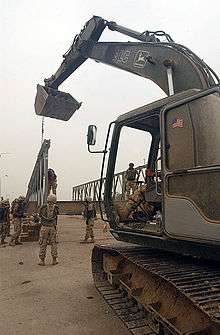
On 28 November 2001 the first members of NMCB 133 arrived at Camp Rhino, Afghanistan as part of Operation Enduring Freedom.[55]
During this deployment it was decided to make Camp X-Ray operational again and 133 sent the battalion's detail at Roosevelt Roads to Guantanamo Bay to make it happen.[56]
January and February 2003 saw the battalion deployed in support of the 1st Marine Expeditionary Force operationally assigned to the 1st MEF Engineer Group.[57] In Southern Iraq the battalion created a POW facility for 14,000, provided defense for 2 bridges and maintenance to the main supply routes as part of Task Force Charlie. Task Force Charlie was made up of NMCB-4, NMCB-74, NMCB-133, CBMU-303 and SU-2 and had a base in Kuwait, Camp Moreell. The men also assembled the largest pontoon bridge since WWII, at Zubadiyah, North of Al Kut, on the Tigris. Another bridge they worked on was the Sarabadi, near Hillah, where they used a Mabey-Johnson Bridge to repair the existing damaged one. The battalion lost a man to a non-combat explosion there from unexploded ordnance. In addition, the battalion completed 60 major Civil Action Projects in Kuwait and Iraq.[54] The unit was active in both Operation Enduring Freedom and Operation Iraqi Freedom.
2005–present
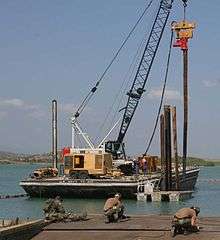

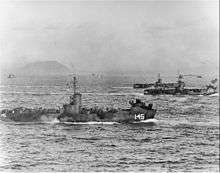
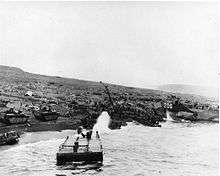

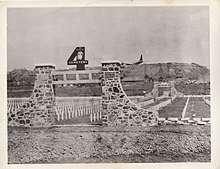
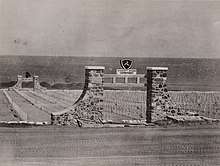
On 29 August 2005 Hurricane Katrina made landfall on the Gulf Coast. Within a day, the Seabees from NMCBs 1, 7, and 133 NCB were tasked to Joint Task Force Katrina.[57] They were joined by NMCBs 18 and 40 plus ACB 2 and CBMUs 202 and 303. During the mission 133 and the other Seabees provided extensive humanitarian aid to the Gulf coast including the homes of their own.[57] "The battalion had 118 who either lost their home entirely or had them damaged beyond repair. That November saw the Battalion deployed to numerous sites across Southwest Asia with dets to Guam and Whidbey Island. In Iraq, NMCB 133 supported Marines, Special Operations Forces and Iraqi Security Forces.
The Battalion's 2007 deployment went to four continents. The battalion worked in support of Combined Joint Task Force – Horn of Africa (CJTF-HOA) building schools in remote villages and making potable water available to the people.[57] A detail assigned to "New Horizons" built schools in rural Belize. NMCB 133 also had a presence in São Tomé, working with Underwater Construction Team ONE (UCT 1) in the reconstruction the Coast Guard only boat launch.[57]
The next two deployments were to Iraq and Okinawa. "NMCB 133's Seabees built the foundation for new buildings on White Beach Naval Facility in Okinawa and restored running water to a village in Malaysia that been without this basic life necessity for over three years. New age power from a wind-turbine and solar panel were used to provide power to the pump.[57] At the end of that PACOM tour, the 133 returned to Gulfport, MS for a 15-month homeport and training cycle.[57]
In March 2010, the battalion deployed over 600 Seabees to Afghanistan in support of the 30,000 troop surge. NMCB 133 created a camp on Kandahar Airfield (KAF), Afghanistan for their main-body site. The location was an undeveloped gravel bed when they arrived. Within a month, a fully operational Seabee camp was built and with the Army a power generating supply was set up.[57] The list of tasks completed by the Seabees of 133 includes:
- drilling a 1,200 feet (370 m) deep well that produces approximately 25,000 US gallons (95,000 l; 21,000 imp gal) of water per day.
- construction of numerous Southwest Asia (SWA) Huts over throughout Afghanistan.
- construction of a base electrical grid, shower units, and mess halls.
- significant expansion of four forward operating bases perimeter defenses.
- construction of numerous crow's nest observation towers.
- construction of 3 helo pads.
In October 2010, NMCB 133 received the Atlantic Fleet Best of Type Battle "E" award for its work during the CENTCOM deployment.[57]
In March 2011, the battalion deployed to Camp Shields, Okinawa. Projects ther included the renovation of the galley facility, a concrete storage building at White Beach Naval Facility, installation of concrete drainage ditches, and general camp improvements to Camp Shields.[57]
In September 2012, NMCB 133 returned to Afghanistan as the last battalion to deploy to there. During that deployment, the battalion twice broke the NCFs longest convoy record.[57]
A bulldozer and a construction crew arrived in Liberia from Djibouti late September 2014. The mission was site preparation near Monrovia Airport for a dozen or medical facilities to be built by the U.S. military's Operation United Assistance to deal with the Ebola crisis in West Africa.[58][59]
Unit awards
NMCB 133 has received several unit citations and commendations. Members who participated in actions that merited the award are authorized to wear the medal or ribbon associated with the award on their uniform. Awards and decorations of the United States Armed Forces have different categories, i.e. Service, Campaign, Unit, and Personal. Unit Citations are distinct from the other decorations. The following unit awards are 133's: [60] [61] [62]

- Navy Unit Commendation: with two bronze stars: 1966–67, Aug–Sept 67, 1968 Vietnam[63]











- Peltier Award: – 11 times.[68]
Campaign and service awards
NMCB 133's Battle Streamer for Vietnam has four bronze stars: the streamer alone counts as the first award. MCB 133 made 3 tours of Vietnam. The conflict was divided into 18 award periods and the battalion qualifies for five.

- Asiatic-Pacific Campaign Medal with the Fleet Marine Force insignia and one arrowhead device
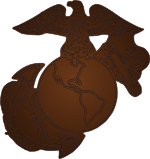













.svg.png)






133's Seabee Teams
- 13301 - - -

- 13304 - - -

- 13305 - - -

- 13306 - - -

- 13307 - - -

- 13308 - - -

- 133Det K-

- 133Det W

- 13314 - - - Letter of Commendation: Secretary of the Navy
- Complete Seabee Teams Report by: Commander Naval Construction Battalion U.S. Pacific Fleet, Tân Sơn Nhất, Republic of Vietnam, Completion Report 1963-1972.
- 1968 five men received the RVN Gallantry Cross and two the Technical Service Medals from Major General Ngô Quang Trưởng, Commander 1st Division ARVN.
- 1969 one Navy & Marine Corps Medal for heroism, one Bronze Star, 14 Purple Hearts, 7 RVN Civic Action Medals and 7 Technical Service Medals
- Fleet Marine Force Combat Operation Insignia[69] The device is a "Restricted" USMC device and is designated as a personal award.[70] The men of the 133rd NCB meet the award requirements: "USN under fire while attached to and under USMC operational control".
List of commanding officers
| Commanding officer | Period | Deployed to: | Detachments |
|---|---|---|---|
| Commander Raymond P. Murphy | Sep 1943 – Sep 1945 | Hawaii, Iwo Jima | A Co to 1st Bn 23rd Marines.,B Co. to 2nd Bn 23rd Marines., C Co.to 3rd Bn 23rd Marines., D Co to 4th Pioneer Bn 25th Marines(assigned to 2nd Bn 25th Marines) |
| Lt. Cdr. Clarence W. Palmer | Sep 45 – Oct 1945 | Iwo Jima | |
| Lt. George R. Imboden | Oct 45 – Nov 1945 | Iwo Jima | det Sasebo with 31st NCB |
| Lt. Thomas P. Cooke | Nov 45 – Dec 1945 | Iwo Jima | |
| Cdr. Edward H. Marsh, II | Aug 66 – Jul 1968 | 1967 Vietnam | [47] |
| Cdr. Frank H. Lewis, Jr. | Jul 68 – Nov 1969 | 1968 Vietnam | Seabee Teams 13301 Tan An and 13302 Phuoc Le[47] |
| " – - – - – - – - – - – - – - – - – - -" | " – - – - – - – - – - -" | 1969 Vietnam | Seabee Team 13303 My Loi, Hue, Thuy Phuoc, Seabee Team 13304 Moen Island[47] |
| Cdr. J. J. Gawarkiewiez, III | Nov 69 – Mar 1971 | 1970 Guam | Vietnam,Azores, Aleutians, Seabee Team 13305 Chau Phu, Long Thanh, Seabee Team 13306 Rach Gia, Seabee Team 13307 Phu Vinh, Seabee Team 13308 Ben Tre[47] |
| Cdr. William C. Conner | Mar 71 – Aug1973 | 1973 Spain | Diego Garcia, Germany, Italy, Crete, Sicily, Greece, Sardinia, Kusaie Island(Seabee Team 13310)[47] |
| Cdr. Leland R. Dobler | Aug 73 – Apr1974 | 1974 Okinawa | Subic Bay, Sasebo, Iwakuni, Taiwan, Misawa, Palau(Seabee Team 13311)[47] |
| Lt. Cdr. Bruce L. McCall | Apr 74 – Jun1974 | 1974 Okinawa | " – - – - – - – - – - – - – - – - – - – - – - – - – - – - – - – - – - – - – - – - – - – - – - – - "[47] |
| Cdr. Richard A. Lowery | Jun 74 – Jul1976 | 1975 Puerto Rico | Gitmo, Bermuda, St. Thomas U.S.Virgin Islands, Vieques Island, Yap Island(Seabee Team 13312)[47] |
| " – - – - – - – - – - – - – - – - – -" | " – - – - – - – - – - – " | 1976 Diego Garcia | [47] |
| Cdr. Gene Davis | Jul 76 – Jul 1978 | 1977 Spain | Sicily, Greece, Crete[47] |
| Cdr. George D. Fraunces | Jul 78 – Oct 1979 | 1978 Puerto Rico | Gitmo, Eleuthera, Antiqua, Keflavik, Diego Garcia, Vieques Island, Yap Island (Seabee Team 13313)[47] |
| " – - – - – - – - – - – - – - – - – - " | " – - – - – - – - – - -" | 1979 Diego Garcia | [47] |
| Capt. Herbert H. Lewis, Jr. | Oct 79 – Jul 1981 | 1981 Guam | Diego Garcia, Midway, Palau, Yokosuka Japan. Seabee Team 13314[47] |
| Capt. Dorwin C. Black | Jul 81 – Jun 1983 | 1982 Spain | Sigonella, Nea Makri Greece, Souda bay, Crete, Holy Loch, Scotland[47] |
| Capt. A. A. Kannegiesser | Jun 83 – Aug 1985 | 1983 Puerto Rico | Guantanamo Bay, Vieques Island, Bermuda, Andros Island, Yap[47] |
| Capt. Richard E. Brown | Aug 85 – Jun 1987 | 1986 Puerto Rico | Guantanamo Bay, Andros Island, Bahamas, Vieques Island, Panama Canal Zone[47] |
| Cdr. Bruce St. Peter | Jun 87 – Aug 1989 | 1987 Okinawa | Adak, Yokusuka, Iwakuni, Yap Island[47] |
| " – - – - – - – - – - – - – - – - – - " | "- – - – - – - – - – - -" | 1989 Spain | Bermuda, Edzell and Holy Loch Scotland, Camp David, Cartagana, Spain[47] |
| Cdr. Donald B. Hutchins | Aug 89 – Sep 1991 | 1990 Guam | Midway, Palau, Philippines, Diego Garcia, Tinian, American Samoa[47] |
| " – - – - – - – - – - – - – - – - – -" | "- – - – - – - – - – - -" | 1991 Iraq/Turkey | [47] |
| Cdr. Douglas F. Elznic | Sep 91 – Jun 1993 | 1991 Spain | Sigonella, Souada Bay Crete, Edzell & Holy Loch Scotland, Camp David, Moron Spain, Ghana, Senegal[47] |
| Cdr. Richard J. McAfee | Jun 93 – Apr 1995 | 1994 Guam | Diego Garcia, Chinhar, Korea, Ban Chan Khrem, Thailand, El Salvador, San Diego CA, Palau-Cat team[47] |
| Cdr. Gary A. Engle | Apr 95 – Jun 1997 | 1995 Spain | Croatia, Bosnia-Herzegovina, Africa, Crete, Sicily, Italy, Great Britain, Camp David[47] |
| Cdr. Paul Bosco | Jun 97 – Jun 1999 | 1997 Guam | San Diego CA, Lemoore CA, Fallon NV, Bangor WA, Kenya, Palau-CAT team, Palau & Kosrae-Tiger team[47] |
| "- – - – - – - – - – - – - – - – - – " | "- – - – - – - – - – - -" | 1998 Spain | Sicily, Crete, St. Mawgan England, Camp David, Bosnia-Herzegovina[47] |
| Cdr. Katherine L. Gregory | Jun 99 – Jul 2001 | 2000 Spain | Sicily, Crete, London, Camp David, Moldova, Tunisia[47] |
| Cdr. Douglas G. Morton | Jul '01 – Jun 2003 | 2001 Guam | Diego Garcia, Bahrain,Carat, Hawaii, Fallon NV, (Lemoore, El Centro, Camp Pendleton, San Diego CA),Bangor WA, Palau-Cat team |
| "- - - - - - - - - - - - - - - - - - -" | "- - - - - - - - - - -" | 2001 Afghanistan | Gitmo |
| "- - - - - - - - - - - - - - - - - - -" | "- - - - - - - - - - - " | 2003 SWA Iraq | Kuwait, Zubaydiyah,Dominican Republic, Andros Island, Gitmo |
| Cdr. Jeffery T. Borowy | Jun '03 – May 2005 | 2003 SWA Iraq | Kuwait |
| Cdr. Allan M. Stratman | May '05 – May 2007 | 2005 Iraq | Guam, Whidby Island |
| Cdr. Paul J. Odenthal | May '07 – Jun 2009 | 2008 Okinawa | Guam,Singapore, Chinhae, Yokosuka, Sasebo, Philippines, San Clemente Island,Palau-Cat team |
| Cdr. Chris M. Kurgan | Jun '09 – May 2011 | 2010 Afghanistan | Kandahar, Tarnak, Beland, Dand, Walakan, Jelawur, FOBs Shindand, Wilson, Walton & Wolverine |
| Cdr. Nick D. Yamodis | May '11 – Jun 2013 | 2011 Okinawa | |
| " - - - - - - - - - - - - - - - - - -" | " - - - - - - - - - - -" | 2012 Afghanistan[71] | Liberia,Niger,Djibouti |
| Cdr. Jeffrey S. Powell | Jun '13 – Jun 2015 | 2014 Spain | Romania, Bahrain, Djibouti, Niger, Chad, Guam, Palau, Micronesia, Kwajalein |
| Cdr. Miguel Dieguez | Jun '15 – Jun 2017 | 2015 Spain | Marshall Islands, Micronesia, Cameroon, Niger, Kwajalein, Guam |
| Cdr. Luke Greene | Jun '17 -present | 2017 Spain | Bahrain, Djibouti, Guam, Kwajalein, Palau- CAT 133-27, Vietnam |
Notes
- On Saipan, the 4th Marine Division assigned the 121st CB and 4th Pioneers as the Shore Party[6]
- On Okinawa, the 1st Marine division Shore Party was composed of 1/2 the 11th Special NCB and the 145th NCB, the Shore Party for the 6th Marine Division was composed of the other half of the 11th Special NCB and the 58th NCB.[72]
- Prior to the 133rd being assigned as the 23rd's Shore Party the 71st NCB had been tasked as the Shore Party for the 3rd Marine Division on Bouganville in 1943.[73]
- "TAD" is contemporary U.S. military terminology that was not used during WWII. During WWII the equivalent terminology was the word "attached".
- The shore party of Peleliu painted a three-inch orange circle on their helmets and greens to identify them from or for the other troops.[74]
- 1944 Construction Battalion combat organization, NAVDOCKS-100, p.i-5
- 17th Special(segregated), 33rd and 73rd CBs were Shore Party with the 1st Pioneers of the 1st Marine Division on Peleliu in 1944.[75][76]
- 25 NCB was Shore Party to the 3rd, 9th and 21st Marine Regiments of the 3rd Marine Division on Guam.
- 41st Naval Construction Regiment: 31st, 62nd, 95th, & 133rd CBs
- 53rd NCB was Shore Party to the 2nd Raiders on Bougainville and Third Raiders on Puruata Island[77]
See also
| Wikimedia Commons has media related to Naval Mobile Construction Battalion 133. |
- Admiral Ben Moreell
- Amphibious Construction Battalion 1 (ACB-1)
- Amphibious Construction Battalion 2 (ACB-2)
- Civil Engineer Corps United States Navy
- Joseph J. McCarthy
- Naval Construction Battalion aka Seabee
- Naval Amphibious Base Little Creek
- Naval Amphibious Base Coronado
- Naval Construction Battalion Center (Gulfport, Mississippi)
- Naval Construction Battalion Center Port Hueneme
- Naval Mobile Construction Battalion 1
- Naval Mobile Construction Battalion 3
- Naval Mobile Construction Battalion 4
- Naval Mobile Construction Battalion 5
- Naval Mobile Construction Battalion 11
- Naval Mobile Construction Battalion 25
- Operation Provide Comfort
- Seabees Memorial
- Seabees in World War II
- USS Logan
- USS Newberry
- USS Mifflin
- USS Lowndes
- 4th Marine Division
- 4th Landing Support Battalion (aka the 4th Pioneers) is now Combat Logistics Battalion 23
- V Amphibious Corps
- 20th Marine Regiment (United States)
- 21st Marine Regiment (United States)
- 23rd Marine Regiment (United States)
- 1st Battalion 23rd Marines
- 2nd Battalion 23rd Marines
- 3rd Battalion 23rd Marines
- 2nd Battalion 24th Marines
- 25th Marine Regiment (United States)
References
- 133 NCB File Folder, Seabee Archives, Seabee Museum, Port Hueneme, CA. 93043
- Rainmakers Log, Commander R.P. Murphy, Leo Hart Co. Rochester, N.Y. 1945, p. 96
- The Amphibians Came to Conquer, The Story of Admiral Richmond Kelly Turner, Chapter XXIII, Iwo Jima, Death at its Best, by George C. Dryer, Vice Admiral, USN (ret), 1969, U.S. GPO, Washington D.C., Library of Congress Catalog Card No. 71-603853
- History of the U.S. Marine Corps in WWII Vol IV- Western Pacific Operations, George w. Garand & Truman R. Strobridge, Historical Branch, G3- Division, Headquarters, U.S.Marine Corps, 1971. pp. 594–595
- Appendix 1, Annex DOG 4th Marine Division Operations Report, April 1945, National Archives, College Park, MD 20742, pp. 1–37 open pdf -Part_6 and pdf -Part_7 for Appendix 1 Annex Dog
- U.S. Army in World War II, Campaign in the Marianas, Chapter VII, Phiilip A. Crowel, U.S.Army, 1959. p. 125
- Iwo Jima Seabees Stay Unsung. Lt. Cdr. Peter S. Marra, U.S. Naval Institute: NAVAL HISTORY, February 1997 pp. 22–25.
- Closing In: Marines in the Seizure of Iwo Jima, Col. Joseph H. Alexander, History and Museums Division, Headquarters U.S. Marine Corps, Washington DC, 1994 p. 22
- Rainmakers Log, Cdr R.P. Murphy, Leo Hart Co. Rochester N.Y. 1946, p. 121
- CLOSING IN: Marines in the Seizure of Iwo Jima, Marines in World War II Commemorative Series by Colonel Joseph H. Alexander U.S. Marine Corps (Ret), Diane Publishing Co, June 1994 ISBN 0788135325 ISBN 9780788135323
- Annex FOX 4th Marine Division's Operations Report, April 1945, National Archives, College Park, MD 20742. (Hq Co REFLECTS BATTALION'S PROPER STATUS FOR AWARD PERIOD PROTOCOL-see support group) pp. 3–4
- Naked Warriors, Lt. Commander Francis Douglas Fane, USNR, St. Martin's Press, 175 Fifth Ave, NY, NY, 10010, 1996, p. 174
- U.S.NSWA Archives, Underwater Demolition Teams Histories, UDT 14
- C Co. 1st Battalion 23rd Marines Official website
- Amphibious Ships (gators)
- Fox Annex 4th Marine Div. Op Report, RCT 23 Operation Report, Section V, Comments and Recommendations, p.67/248
- Annex FOX 4th Marine Div. Op Report for the 23rd RCT on Iwo Jima p. 3
- From Omaha to Okinawa: The Story of the Seabees, William Bradford Huie, E.P. Dutton, New York 1945 p. 43
- Annex FOX 4th Marine Div. Op Report for the 23rd RCT on Iwo Jima p. 11
- KXii News Channel 12, Iwo Jima Vet
- Amphibious Ships (gators)
- USS Lowndes
- Annex HOW to the 4th Marine Div. Op Report for the 25th RCT on Iwo Jima, open pdf -Part 1 for section I pp. 1, 12 Archived 16 February 2017 at the Wayback Machine
- Appendix 1 Annex Dog to the 4th Marine Division's Operations Report April 1945
- Phonetic Alphabet. U.S. Naval Historical Center, % Chief of Information U.S. Navy, 1200 Navy Pentagon, Washington, D.C. 20350
- 133 NCB File Folder, Seabee Archives, Seabee Museum, Port Hueneme,CA 93034
- Iwo Jima Seabees Stay Unsung. Lt. Cdr. Peter S., Marra, U.S. Naval Institute: NAVAL HISTORY, February 1997 pp. 22–25
- Iwo Jima, Richard F. Newcomb, Henry Holt & Co,1965 NY,NY,. p. 112–128
- The United States Marines on Iwo Jima- The Battle and the Flag Raisings, Bernard C. Nalty & Danny J. Crawford, History & Museums Division, Headquarters, U.S. Marine Corps, Washington, D.C. 1995. (133's AWARD PROTOCOL ERROR IS ON- p. 26) (see correct listing 4th and 5th Pioneers same page)
- FOX Annex 4th Marine Division Operations Report, April 1945. p. 6 of 248, line 12 from top of page
- Rainmakers Log, Commander R.P.Murphy, Leo Hart Co. Rochester, N.Y. 1946 p. 112
- Rainmakers Log, Commander R.P. Murphy, Leo Hart Co. Rochester, N.Y. 1945, pp. 161-181
- The U.S. Navy in WWII, Mark Henry, Osprey Publishing, p.24[file:///C:/Users/cbuser01/Desktop/The%20US%20Navy%20in%20World%20War%20II%20-%20Mark%20Henry%20-%20Google%20Books.html]
- USN press release, 4/12/1945, John B. GRIFFIN S1c, CB Overseas Correspondent, 8th Naval Construction Regiment, Seabee Museum, Port Hueneme, Ca.9
- Col. Shelton Scales and 133rd NCB, Fighting Seabees of Iwo Jima on "War Stories" YouTube with Lt. Col. Oliver NorthCol. Shelton Scales and 133rd NCB": Fighting Seabees of Iwo Jima on "War Stories" YouTube with Lt. Col. Oliver North
- NCB 133 PUC Recommendation, Col. Shelton Scales, Board for Correction of the Naval Record, 720 Kennon St. SE. suite 309, Washington Navy Yard, DC 20374
- NCB 133 PUC RECOMMENDATION, Lt. General Snowden, Board for Correction of the Naval Record, 720 Kennon St. SE. suite 309, Washington Navy Yard, DC 20374
- 8th NCB File Folder. Seabee Museum Archives, Port Hueneme,CA 93043
- Seabee Museum Archives file for the 133rd NCB
- Disney Studio Archives, Burbank, CA 91521
- Rainmakers Log, Commander R.P. Murphy, Leo Hart Co, Rochester, N.Y. 1946 p. 6
- This Week in Seabee History, 12 August 1966, Seabee Magazine On-line
- Southeast Asia, Building the Bases, Richard Tregaskis, U.S.Government Print Office, 1975, pp. 355-62
- Naval History and Heritage Command, U.S. Navy Seabee Museum, The Ghost Battalion
- NHHC, Seabee Museum website, MCB 11 cruise-book, 1969, p. 68
- MCB121 Tank, Legiontown U.S.A., American Legion online magazine, December 4, 2018
- DEPLOYMENT COMPLETION REPORTS
- Hurricane Camille & the Navy Seabees in 1969 – Full Documentary, Documentary Tube, 1971[]
- NHHC: U.S. Navy Seabee Museum: NMCB 133 Cruisebooks 1967–1977
- Seabee Museum Archives, Port Hueneme CA 93043, NMCB 133./
- NMCB 133 Historical Information Seabee Museum Archives, Port Hueneme,CA 93043, NMCB 133 Historical Information
- Humanitarian Operations in Northern Iraq, 1991-With Marines in Operation Provide Comfort, LCol Ronald J. Brown, History and Museums Division, Headquarters U.S. Marine Corps, Washington, D.C. p. 69
- The Citizen's Guide to the U.S.Navy, Thomas J. Cutler, Naval Institute Press,291 Wood Road, Annapolis, MD, 2012
- Seabee Museum Archives, Port Hueneme, CA 93043, NMCB 133 Historical Information NMCB 133 Historical Information
- This week in Seabee History by Dr. Frank A. Blazich Jr., Historian, Naval History and Heritage Command, Seabee Museum Archives, Port Hueneme, Ca.
- 133 Unit History, NCF Official website, Commander, Naval Construction Group TWO, 5101 Marvin Shields Blvd, Gulfport, MS 39501
- Official website
- U.S. Troops Battling Ebola Get Off to Slow Start in Africa, Drew Hinshaw, Betsy McKay, The Wall Street Journal, =28 September 2014[]
- United States Africa Command website; 24 Sept 2014
- US Navy Awards, Chief of Naval Operations, 2000 Navy Pentagon, Washington, D.C. 20350 NAVY HAS MADE ADDRESS NON-PUBLIC
- Navy and Marine Corps Awards Manual, Department of the Navy, NAVPERS 15,790 (Rev. 1953)
- List of Award Abbreviations, Chief of Naval Operations, 2000 Navy Pentagon, Washington, D.C. 20350 Archived 31 January 2017 at the Wayback Machine
- U.S. Navy OP-09819- dated 04/19/77
- OPNAV NOTICE 1650
- DOD Approved JUMAs 31/12/2012 p. 5
- |NMCB133 Veterans webpage
- Battle "E" Peltier Perry Awards, Seabee Museum Archives, Port Hueneme, CA 93043
- Seabee onLine Magazine, 1322 Peterson Ave., S.E., Bldg. 33, Suite 1000, Washington Navy Yard, D.C. 20374
- Naval Personnel Command, 5301-5319 Awards. 5319 #2
- Dept. of the Navy, SECNAVINST 1650.1H pp. 1–9
- Seabee Magazine, Change of Command, July 15, 2013
- Okinawa: Victory in the Pacific, Major Chas. S. Nichols Jr, USMC Historical Section, United States Marine Corps, Quantico, VA, Appendix IV
- 71st U.S Naval Construction Battalion, Seabee Museum Archives, Port Hueneme, CA p. 14
- Peleliu Shore Party Group
- World War II Database
- Seabee Museum Archives, Port Hueneme, CA. 93043. 17th Special; NCB p. 29
- 53rd Naval Construction Battalion, Seabee Museum Archives, Port Hueneme, CA 93043. pp. 14, 106
External links and further reading
| Wikimedia Commons has media related to Naval Mobile Construction Battalion 133. |
- A 133 vet's Iwo account.
- Amphibious Operations Report, Capture of Iwo Jima, 16 February to 16 March 1945, UNITED STATES FLEET, Headquarters of the Commander in Chief, NAVY DEPARTMENT, WASHINGTON 25, D.C., 17 July 1945, p. 5-3 to 5-6
- Annex Fox, RCT 23 Operation Report Section V, Comments and Recommendations, (4. Supply) Shore Party, Beach Party, p. 64/248
- Bloodstained Sands: US. Amphibious Operations in World War II, Michael G. Walling, Bloomsbury Publishing Plc. 2017. p. 434 (A Co. 133)
- Col. Shelton Scales and 133rd NCB": Fighting Seabees of Iwo Jima on "War Stories" YouTube with Lt. Col. Oliver North
- Navy Civil Engineer Corps Bulletin, Vol 2 NAVDOCKS P-2 No 14, January 1948, Iwo Jima
- NMCB 133 Command home page
- NAVDOCKS-100, January 1944, U.S.Naval Construction Battalion Administration Manual
- NMCB 62 Alumni website
- William Bradford Huie: From Omaha to Okinawa- The Story of the Seabees 1945, Chapter II, Iwo Jima, p. 27–88
- 4th Marine Division Operations Report, Iwo Jima
- 133 NCB & NMCB 133 Unit Histories and Cruisebooks NHHC: Seabee Museum search "deployment completion reports"
